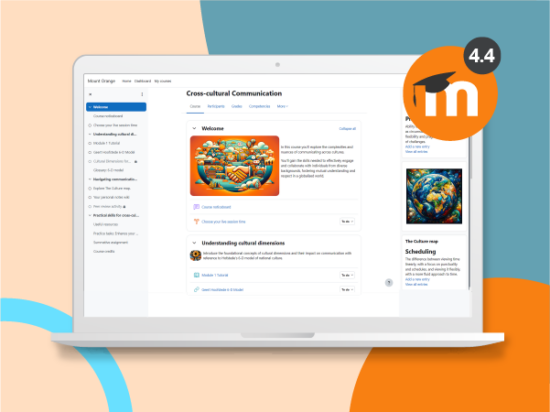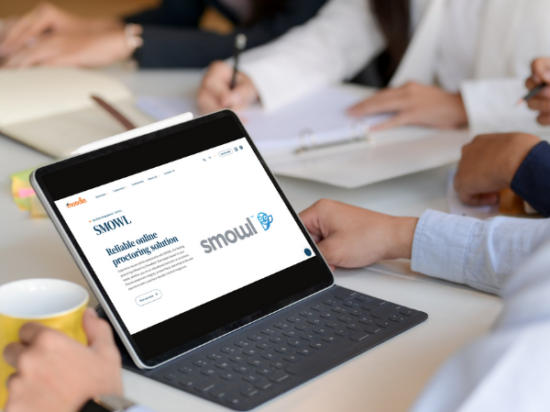We have been talking about MoodleMoots a lot lately! There are many more MoodleMoots being added to our “Find Your Moot” world map on our MoodleMoot website and we, at Moodle HQ, are looking forward to hosting some Moots of our own.
The first Moodle HQ run MoodleMoot will be MoodleMoot UK & Ireland 2017, held in London from 10 – 12 April.
Last week, we talked to Richard Olemann, who gave us an insight into what to expect at a MoodleMoot – from workshops, masterclasses, presentations, debates through to social activities.
We’ve been lucky to catch up with Aurélie Owens, Learning Technologist, from Cranfield University, this week, who presented at last year’s MoodleMoot UK & Ireland.
Aurélie has been kind enough to share with us her insight as a presenter at a MoodleMoot – why present, what to present and tips on how to deliver an engaging and successful presentation.
Moodle HQ: Thank you Aurélie for taking the time to talk to us today. We’re really interested to find out about your experience presenting at a MoodleMoot, which you did last year. So maybe let’s start with “why?” did you want to present at this conference? What did you get out of presenting?
Aurélie Owens: Thank you for giving me the opportunity to share my experience.
Last year was my first chance to attend and present at a MoodleMoot. Both my colleague Sam Taylor and I wanted to share our work in two distinctive areas and ask for further feedback for development via a MoodleMoot. This is why we decided to submit a proposal to present.
Moodle HQ: And once you decided to present, you submitted a presentation proposal. How did you go about creating a proposal? What was the process you went through? How did you choose your topic?
Aurélie Owens: Sam and I decided to both co-present each other’s topics.
Colleagues from other institutions had been asking questions on details of what we were doing with Turnitin inductions via Moodle and with Mahara Group portfolio integration with Moodle. We therefore decided to take the opportunity to share our experience on those two topics.
This gave us the reassurance that we were covering the breadth of each of our topics, as well as proofreading, having a soundboard and moral support. After we identified those two topics, we focused on our own topics initially and clarified the scope. The presentation time is fairly short so we knew we had to concentrate on the key points. For my presentation, in order to write the proposal, I started putting the key points headings on slides without content, or with very brief notes at this point, to ensure I knew what would be covered.
I then proceeded to summarise the ‘problem’ I was going to discuss in the presentation with an outline of what I would cover. By doing so, you quickly get to the word limit for the abstract so the rest of the process is to eliminate superfluous adverbs and unnecessary information in the text. In this case, we used each other to check and review the abstract content. It was useful to have that dialogue as it further focused the points I was trying to get across in the paper.
I would always advise you get someone to proofread your abstract, however intimidating this may sound, and take all constructive feedback from your proofreader.
Moodle HQ: We know attendees learn a lot at MoodleMoots, but what did you learn or enjoy most in your role as a presenter?
Aurélie Owens: I learnt a huge amount at MoodleMoot UK & Ireland 2016 plus presenting the two papers was extremely enjoyable. The conference was very well organised and this helped reduce nerves as everything was running well.
Getting questions and feedback on my paper was very useful. It helped with networking too because, following my presentation, I talked with other Moodle users who were interested in how we had implemented our Moodle/Turnitin inductions. We ended up creating our own Moodle course page to ask for feedback from other Moodle users on how the Moodle/Turnitin integration gets rolled out in their institutions and any suggestions for improvement.
Moodle HQ: You indicated that you are submitting a presentation for MoodleMoot UK & Ireland 2017. That’s great and we look forward to receiving your submission. Can you provide us with a hint as to what you might be presenting on, if it’s not top secret?
Aurélie Owens: I have indeed already registered for MoodleMoot 2017 and I am about to submit two proposals.
I do need to further develop the content but I can outline the topics without breaking any secrets! The presentation proposal will be showcasing how we used and stretched our standard Moodle course and tools to develop, from scratch, and successfully roll out a ten-week self-paced ‘open’ programme for our researchers and academics.
The poster proposal is around utilising Moodle tools to design and support course accreditation documentation and workflow, integrated with an e-portfolio.
Moodle HQ: Lastly, presenting on stage is nerve-wracking for a lot of people. What advice would you give to people presenting at a MoodleMoot? What tips do you have or what tricks do you employ to deliver a top presentation?
Aurélie Owens: Both Sam and I are qualified teachers and used to present to students but a conference presentation involves a different audience. Additionally, I am not an English native speaker (I am French). I was therefore slightly nervous but I knew I was well prepared so, apart from starting my presentation with an unusually heavy French accent due to being a bit nervous, it all went fine!
We all come with a different confidence level but all the advice I would give is about planning and practising. If it is your first MoodleMoot, some recordings of last year’s MoodleMoot are on YouTube, so you can watch a few to check how others are presenting their papers.
Do read carefully the comments from the proposal reviewers. It helped me with putting my presentation together.
If you can present with a colleague like we did, it is useful to have that additional support.
I would also advise to rehearse the presentation until you are pretty fluent at running through the slides without notes. On the day, do take the notes with you to remind you of the key points, in case nerves take over.
For the presentation slides, ensure there isn’t too much text on the slide and keep the number of slides to a reasonable amount: you don’t want to be flicking through tons of slides. It’s better to use those as prompts and you talk to the audience.
Do add your social media handles (e.g. Twitter) in your slides if you use social media as it makes it easier for the audience to ask you further questions, connect and contact you after the conference.
My top tip is to be as natural as you can and remember to breathe: we are all here to learn from each other. As long as you practise the presentation, it will be just fine.
I am really looking forward to three great days of learning and networking in April!
Thank you for taking the time to share your experiences with us Aurélie.
If you would like to view the presentation that Aurélie and her colleague Sam conducted for MoodleMoot UK & Ireland 2016, titled “Enhancing Group Assessment with Moodle” you can view it on our YouTube channel.
Thanks again Aurélie. We really appreciate it and we look forward to seeing you back on stage together with other presenters at MoodleMoot UK & Ireland 2017.
If you would like to submit a presentation for a MoodleMoot UK & Ireland please visit: https://moodlemoot.org/mootieuk/submit-a-presentation/
Find out more about MoodleMoot UK & Ireland 2017 or register your spot today!



